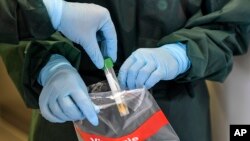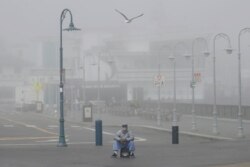U.S. President Donald Trump is blocking European travelers from entering the United States. Italy is limiting travel within the country to just the essentials. China locked down tens of millions of people, all in an effort to contain the spread of COVID-19.
While travel bans may slow the outbreak somewhat, a growing body of research is showing that the best tool is one that is falling short in the United States: testing and isolating infected people.
When the coronavirus erupted in Wuhan, China put in place unprecedented measures, limiting people's movement, canceling large gatherings, testing huge numbers of people and isolating the infected.
Experts say these measures have tamed the epidemic in China. After more than 80,000 infections and more than 3,000 deaths, the country now is reporting just a few dozen cases per day.
Without those actions, the outbreak would have been 67 times worse, according to a new study published on the preprint server medRxiv.
Other experts have not yet reviewed the study for accuracy.
Biggest impact
As other countries grapple with their own exploding epidemics, the authors sought to figure out which of the three sets of measures — travel bans, social distancing, and detecting and isolating patients — were most effective.
"The most important one, the biggest effect, was the early detection and isolation of cases," said Andrew Tatem of the University of Southampton who co-authored the report.
Without early detection and isolation, China would have seen five times as many cases. Without social distancing, there would have been 2.6 times more, according to the study.
"But importantly, all three of those together had the biggest effect," Tatem added.
Travel restrictions have a role to play, he said. They likely contributed less than the other measures in part because an estimated 5 million people had already left Wuhan, the epicenter of the outbreak, by the time authorities imposed them.
"Acting early is pretty important," Tatem added.
An earlier study found that China's travel ban slowed the outbreak there by just 3 to 5 days, and internationally by 2 to 3 weeks.
Too little, too late
Trump said travel restrictions he imposed on China in February delayed the outbreak in the United States, and restricting travel from Europe would have the same effect.
"The European Union failed to take the same precautions and restrict travel from China and other hotspots," Trump said in an Oval Office address Wednesday. "As a result, a large number of new clusters in the United States were seeded by travelers from Europe."
However, with coronavirus already spreading across the United States, experts say the new restrictions are unlikely to make much of a difference in this country.
"If you want to take a lesson from (the new study)," said virologist Christopher Mores at George Washington University, "it's that travel bans might be very effective at reducing the likelihood of (virus) introduction" at the beginning of an epidemic, "but once it's there, (containment) is wholly dependent on case isolation and social distancing."
"What is the ongoing value of a travel ban alone?" he added. "We're not doing the other things."
U.S. health authorities are struggling to identify and isolate patients because of a lack of testing capacity, despite assurances from Trump that testing is "going very smooth."
"The system is not geared toward what we need right now," National Institute of Allergy and Infectious Diseases chief Dr. Anthony Fauci told Congress Thursday. "That is a failing. Let's admit it."
Emotional reactions
Without good information on where and how the virus is spreading in the United States, school closures, event cancellations and other social distancing measures are happening without any data to back them up, Mores said.
"We can end up with a whole lot of decisions that are emotional," he added, "and have great potential to either under- or overreact."
Some of these measures may be best left in place for months to keep the virus from roaring back, Tatem's study notes, which would be hugely disruptive and a massive hit to the economy.
With so many unknowns still surrounding how this new virus behaves, it's not clear when it will be OK to let up. For that matter, it's not entirely clear when it's best to clamp down.
"The timing is important to consider," noted Georgetown University health policy expert Claire Standley. "At what point does that trigger need to be pulled? And is it better to go straight to the full-on interventions first, rather than waiting for cases to explode in the meantime?"
"I don't know the answer to this," she said. "I don't know if anyone does."










